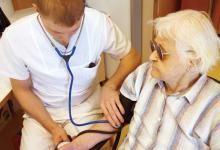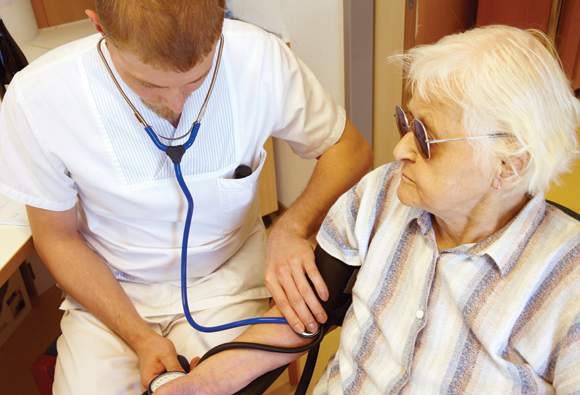User login
Diabetes Hub contains news and clinical review articles for physicians seeking the most up-to-date information on the rapidly evolving options for treating and preventing Type 2 Diabetes in at-risk patients. The Diabetes Hub is powered by Frontline Medical Communications.
VIDEO: SPRINT is practice changer; good news for elderly patients
ORLANDO – Results from the SPRINT hypertension trial are “truly practice changing,” by “giving us definitive clinical-trial evidence that an additional 15-18 mm Hg lowering of systolic blood pressure, aiming for a target of less than 120 mm Hg, translates into” a significantly reduced composite cardiovascular-event endpoint as well as significantly reduced all-cause death, Dr. Gregg C. Fonarow said in an interview at the American Heart Association scientific sessions.
The significant, 27% relative reduction in all-cause mortality in SPRINT in patients targeted to a systolic blood pressure of less than 120 mm Hg was especially notable because an all-cause mortality benefit is not typically seen with other interventions, and because it “ultimately demonstrates that the benefits clearly outweigh the potential risks,” said Dr. Fonarow, professor and associate chief of cardiology at the University of California, Los Angeles.
Dr. Fonarow acknowledged that results from SPRINT showed a more aggressive regimen also produced higher rates of certain important adverse effects, such as acute kidney injury. But the large incremental benefit in total mortality during the greater than 3 years of average follow-up showed the overwhelming net benefit from more aggressive antihypertensive treatment.
Less clear is whether the SPRINT results say anything about initiating antihypertensive treatment in a patients who resemble those enrolled in the trial and have an untreated systolic blood pressure of 130-139 mm Hg. While people like these could enter SPRINT, they constituted just under 10% of the enrolled population.
“The vast majority of patients in the trial met the conventional clinical definition of hypertension, with a systolic blood pressure of 140 mm Hg or greater and already on some treatment, and treating them to a systolic pressure of less than 120 mm Hg, usually by adding just one antihypertensive drug, translated into substantial clinical benefit,” Dr. Fonarow concluded. He also noted that a large subgroup, about 28% of enrolled patients, were at least 75 years old, and in these patients the more aggressive regimen was as safe and effective as in the entire study. “We have a spectacular result” for elderly patients, he said.
Dr. Fonarow had no disclosures.
The video associated with this article is no longer available on this site. Please view all of our videos on the MDedge YouTube channel
On Twitter @mitchelzoler
ORLANDO – Results from the SPRINT hypertension trial are “truly practice changing,” by “giving us definitive clinical-trial evidence that an additional 15-18 mm Hg lowering of systolic blood pressure, aiming for a target of less than 120 mm Hg, translates into” a significantly reduced composite cardiovascular-event endpoint as well as significantly reduced all-cause death, Dr. Gregg C. Fonarow said in an interview at the American Heart Association scientific sessions.
The significant, 27% relative reduction in all-cause mortality in SPRINT in patients targeted to a systolic blood pressure of less than 120 mm Hg was especially notable because an all-cause mortality benefit is not typically seen with other interventions, and because it “ultimately demonstrates that the benefits clearly outweigh the potential risks,” said Dr. Fonarow, professor and associate chief of cardiology at the University of California, Los Angeles.
Dr. Fonarow acknowledged that results from SPRINT showed a more aggressive regimen also produced higher rates of certain important adverse effects, such as acute kidney injury. But the large incremental benefit in total mortality during the greater than 3 years of average follow-up showed the overwhelming net benefit from more aggressive antihypertensive treatment.
Less clear is whether the SPRINT results say anything about initiating antihypertensive treatment in a patients who resemble those enrolled in the trial and have an untreated systolic blood pressure of 130-139 mm Hg. While people like these could enter SPRINT, they constituted just under 10% of the enrolled population.
“The vast majority of patients in the trial met the conventional clinical definition of hypertension, with a systolic blood pressure of 140 mm Hg or greater and already on some treatment, and treating them to a systolic pressure of less than 120 mm Hg, usually by adding just one antihypertensive drug, translated into substantial clinical benefit,” Dr. Fonarow concluded. He also noted that a large subgroup, about 28% of enrolled patients, were at least 75 years old, and in these patients the more aggressive regimen was as safe and effective as in the entire study. “We have a spectacular result” for elderly patients, he said.
Dr. Fonarow had no disclosures.
The video associated with this article is no longer available on this site. Please view all of our videos on the MDedge YouTube channel
On Twitter @mitchelzoler
ORLANDO – Results from the SPRINT hypertension trial are “truly practice changing,” by “giving us definitive clinical-trial evidence that an additional 15-18 mm Hg lowering of systolic blood pressure, aiming for a target of less than 120 mm Hg, translates into” a significantly reduced composite cardiovascular-event endpoint as well as significantly reduced all-cause death, Dr. Gregg C. Fonarow said in an interview at the American Heart Association scientific sessions.
The significant, 27% relative reduction in all-cause mortality in SPRINT in patients targeted to a systolic blood pressure of less than 120 mm Hg was especially notable because an all-cause mortality benefit is not typically seen with other interventions, and because it “ultimately demonstrates that the benefits clearly outweigh the potential risks,” said Dr. Fonarow, professor and associate chief of cardiology at the University of California, Los Angeles.
Dr. Fonarow acknowledged that results from SPRINT showed a more aggressive regimen also produced higher rates of certain important adverse effects, such as acute kidney injury. But the large incremental benefit in total mortality during the greater than 3 years of average follow-up showed the overwhelming net benefit from more aggressive antihypertensive treatment.
Less clear is whether the SPRINT results say anything about initiating antihypertensive treatment in a patients who resemble those enrolled in the trial and have an untreated systolic blood pressure of 130-139 mm Hg. While people like these could enter SPRINT, they constituted just under 10% of the enrolled population.
“The vast majority of patients in the trial met the conventional clinical definition of hypertension, with a systolic blood pressure of 140 mm Hg or greater and already on some treatment, and treating them to a systolic pressure of less than 120 mm Hg, usually by adding just one antihypertensive drug, translated into substantial clinical benefit,” Dr. Fonarow concluded. He also noted that a large subgroup, about 28% of enrolled patients, were at least 75 years old, and in these patients the more aggressive regimen was as safe and effective as in the entire study. “We have a spectacular result” for elderly patients, he said.
Dr. Fonarow had no disclosures.
The video associated with this article is no longer available on this site. Please view all of our videos on the MDedge YouTube channel
On Twitter @mitchelzoler
EXPERT ANALYSIS FROM THE AHA SCIENTIFIC SESSIONS
Key clinical point: SPRINT results showed significant added benefit from treating selected patients with cardiovascular disease risk to a systolic blood pressure of less than 120 mm Hg.
Equation predicts blindness, amputation risk in diabetes
Researchers have developed and validated a set of algorithms to predict the likelihood that a patient with diabetes will develop blindness or require a limb amputation within 10 years, according to a paper published online Nov. 11 in the BMJ.
Using data from a British prospective cohort study of 454,575 primary care patients with diabetes, researchers looked at a large selection of risk factors for vascular disease, used these to develop risk prediction equations for men and women, then validated the equations in two separate cohorts totaling 348,469 patients.
They found that for men in one of the two validation cohorts, the equations explained 40.6% of the variation in the time to amputation and 31.9% in time to blindness, with similar results for women (BMJ. 2015 Nov 11. doi: 10.1136/bmj.h5441).
“To our knowledge, these are the first tools for predicting the 10-year risk of both blindness and amputation, two of the complications that most concern patients with diabetes and affect quality of life,” wrote Dr. Julia Hippisley-Cox, professor of clinical epidemiology and general practice, Faculty of Medicine & Health Sciences, and Carol Coupland, Ph.D., both from the University of Nottingham (England).
“For clinicians and the health service, more accurate methods for stratifying patients according to their absolute risk of complications could enable screening programs to be tailored to an individual’s level of risk and support the more rational use of scarce resources.”
The authors declared a directorship or consultancy with ClinRisk, which produces software for the implementation of clinical risk equations within clinical computer systems.
The risk factors in these final models – such as age, ethnicity, blood pressure, deprivation, glycated hemoglobin, and smoking for the amputation risk model – are what we might expect on the basis of previous research on complications of diabetes, but it is very useful to have the effect of each of these risk factors quantified.
People with diabetes can for the first time be given individualized risk scores based on their own characteristics and can also be shown how changes in their lifestyle or diabetes management affect their risk – for example, stopping smoking or tightening their blood glucose control – thus promoting more patient-centered care for people with diabetes.
Dr. Azeem Majeed is professor of primary care at Imperial College London and Dr. Mariam Molokhia is clinical reader in epidemiology and primary care at King’s College London. These comments are taken from an accompanying editorial (BMJ. 2015 Nov 11. doi: 10.1136/bmj.h5643). Neither author declared any conflicts of interest.
The risk factors in these final models – such as age, ethnicity, blood pressure, deprivation, glycated hemoglobin, and smoking for the amputation risk model – are what we might expect on the basis of previous research on complications of diabetes, but it is very useful to have the effect of each of these risk factors quantified.
People with diabetes can for the first time be given individualized risk scores based on their own characteristics and can also be shown how changes in their lifestyle or diabetes management affect their risk – for example, stopping smoking or tightening their blood glucose control – thus promoting more patient-centered care for people with diabetes.
Dr. Azeem Majeed is professor of primary care at Imperial College London and Dr. Mariam Molokhia is clinical reader in epidemiology and primary care at King’s College London. These comments are taken from an accompanying editorial (BMJ. 2015 Nov 11. doi: 10.1136/bmj.h5643). Neither author declared any conflicts of interest.
The risk factors in these final models – such as age, ethnicity, blood pressure, deprivation, glycated hemoglobin, and smoking for the amputation risk model – are what we might expect on the basis of previous research on complications of diabetes, but it is very useful to have the effect of each of these risk factors quantified.
People with diabetes can for the first time be given individualized risk scores based on their own characteristics and can also be shown how changes in their lifestyle or diabetes management affect their risk – for example, stopping smoking or tightening their blood glucose control – thus promoting more patient-centered care for people with diabetes.
Dr. Azeem Majeed is professor of primary care at Imperial College London and Dr. Mariam Molokhia is clinical reader in epidemiology and primary care at King’s College London. These comments are taken from an accompanying editorial (BMJ. 2015 Nov 11. doi: 10.1136/bmj.h5643). Neither author declared any conflicts of interest.
Researchers have developed and validated a set of algorithms to predict the likelihood that a patient with diabetes will develop blindness or require a limb amputation within 10 years, according to a paper published online Nov. 11 in the BMJ.
Using data from a British prospective cohort study of 454,575 primary care patients with diabetes, researchers looked at a large selection of risk factors for vascular disease, used these to develop risk prediction equations for men and women, then validated the equations in two separate cohorts totaling 348,469 patients.
They found that for men in one of the two validation cohorts, the equations explained 40.6% of the variation in the time to amputation and 31.9% in time to blindness, with similar results for women (BMJ. 2015 Nov 11. doi: 10.1136/bmj.h5441).
“To our knowledge, these are the first tools for predicting the 10-year risk of both blindness and amputation, two of the complications that most concern patients with diabetes and affect quality of life,” wrote Dr. Julia Hippisley-Cox, professor of clinical epidemiology and general practice, Faculty of Medicine & Health Sciences, and Carol Coupland, Ph.D., both from the University of Nottingham (England).
“For clinicians and the health service, more accurate methods for stratifying patients according to their absolute risk of complications could enable screening programs to be tailored to an individual’s level of risk and support the more rational use of scarce resources.”
The authors declared a directorship or consultancy with ClinRisk, which produces software for the implementation of clinical risk equations within clinical computer systems.
Researchers have developed and validated a set of algorithms to predict the likelihood that a patient with diabetes will develop blindness or require a limb amputation within 10 years, according to a paper published online Nov. 11 in the BMJ.
Using data from a British prospective cohort study of 454,575 primary care patients with diabetes, researchers looked at a large selection of risk factors for vascular disease, used these to develop risk prediction equations for men and women, then validated the equations in two separate cohorts totaling 348,469 patients.
They found that for men in one of the two validation cohorts, the equations explained 40.6% of the variation in the time to amputation and 31.9% in time to blindness, with similar results for women (BMJ. 2015 Nov 11. doi: 10.1136/bmj.h5441).
“To our knowledge, these are the first tools for predicting the 10-year risk of both blindness and amputation, two of the complications that most concern patients with diabetes and affect quality of life,” wrote Dr. Julia Hippisley-Cox, professor of clinical epidemiology and general practice, Faculty of Medicine & Health Sciences, and Carol Coupland, Ph.D., both from the University of Nottingham (England).
“For clinicians and the health service, more accurate methods for stratifying patients according to their absolute risk of complications could enable screening programs to be tailored to an individual’s level of risk and support the more rational use of scarce resources.”
The authors declared a directorship or consultancy with ClinRisk, which produces software for the implementation of clinical risk equations within clinical computer systems.
FROM BMJ
Key clinical point: A set of clinical algorithms based on vascular risk factors can help predict the risk of blindness or limb amputation in patients with diabetes.
Major finding: The equations explained 40.6% of the variation in the time to amputation and 31.9% in time to blindness in men.
Data source: A British prospective cohort study of 454,575 primary care patients with diabetes and two validation cohorts of 348,469 patients.
Disclosures: The authors declared a directorship or consultancy with ClinRisk Ltd., which produces software for the implementation of clinical risk equations within clinical computer systems.
Short-term adverse events modest after bariatric surgery in slimmer diabetics
LOS ANGELES – A nationwide analysis shows modest early morbidity and low mortality following bariatric surgery in patients with type 2 diabetes who are not morbidly obese.
At 30 days’ follow-up among 1,003 patients, the composite complication rate, defined as the presence of any of 16 adverse events, was 4.2%; the reoperation rate was 1.6%; and two patients (0.2%) died.
“A 2-hour surgical procedure requiring a 2-day hospital stay that is associated with low morbidity and mortality can lead to remission of a chronic, progressive, and disabling disease,” lead author Dr. Ali Aminian of the Cleveland Clinic said at Obesity Week 2015.
“Based on these findings, bariatric surgery can be considered a relatively safe option for managing type 2 diabetes in patients with mild obesity.”
The analysis included adults with a body mass index of at least 25 kg/m2, but less than 35 kg/m2 (mean, 33 kg/m2).
These data are important because most patients with type 2 diabetes fall into this BMI category, he said.
Most of the patients were women (74.3%), 40% were using insulin, 78% had hypertension, and 9% had cardiac disease, according to the analysis, drawn from the American College of Surgery National Surgical Quality Improvement Program 2005-2013 database.
Roux-en-Y bypass was performed in 574 patients, adjustable gastric banding in 227, sleeve gastrectomy in 189, and duodenal switch in 13.
The most common adverse events overall were blood transfusion and reoperation (both 1.6%), a hospital stay longer than 7 days (0.6%), and organ space surgical-site infection (0.5%).
Composite morbidity and mortality was highest in the Roux-en-Y bypass group, compared with the adjustable banding and sleeve groups (5% vs. 3.1% vs. 3.2%, respectively), Dr. Aminian said at the meeting, presented by the Obesity Society and the American Society for Metabolic and Bariatric Surgery.
Only 3 of 46 patients with a BMI of less than 30 kg/m2 had an adverse event.
Available randomized controlled trials can’t clearly resolve the safety concerns of bariatric surgery in the subgroup of patients with type 2 diabetes who are overweight and mildly obese because such small trials are unlikely to reveal uncommon but clinically serious complications, Dr. Aminian said. In addition, many of the trials have screened out low-BMI and high-risk patients.
Those in attendance at the presentation, however, weren’t entirely convinced the current analysis could allay all safety concerns.
Session comoderator Dr. Daniel Cottam, a bariatric surgeon in group practice in Salt Lake City, said, “I like the summary; however, the use of the word ‘safe’ can be taken to mean a lot of things. It’s one of those squishy words.”
Though the authors have shown that bariatric surgery can be performed in diabetics with a low BMI, in order to say it is safe, the comparison needs to be drawn to the all-cause mortality for these patients in the general population and with other surgical procedures.
“That would be useful in the manuscript because as we approach our patients, we want to be able to say, ‘Listen, if you live with diabetes and a BMI of 25-35 for 5 years, this is your all-cause mortality, and surgery is going to save your life, not hurt it,’ ” Dr. Cottam said.
Along the same lines, Dr. Harvey Sugerman emeritus professor of surgery at Virginia Commonwealth University in Richmond, commented, “Like the old days of routinely operating on any patient with diabetes and gallstones, the data were that just having one death in a young person and the quality-of-life-years lost, it would take you thousands of gallbladders to make up for that one death.”
Dr. Sugarmen also asked for details on the deaths including where they occurred, in whom, and whether the centers were inexperienced.
Dr. Aminian could not recall at the time, but in an interview with this news organization said one death was in a 61-year-old with a history of cardiac disease and chronic kidney failure secondary to insulin-dependent diabetes who developed postop bleeding after gastric bypass. The second was in a 59-year-old patient, again on insulin, who was discharged without problems after gastric bypass, but died within 30 days after surgery.
Although most serious complications occur in this period, the main limitation of the study is that the dataset does not capture adverse events beyond 30 days after surgery, which can lead to underestimation of real risk, Dr. Aminian told the crowd.
“Further large clinical studies on long-term safety and efficacy outcomes of bariatric surgery in patients with type 2 diabetes and low BMI are warranted,” he said.
LOS ANGELES – A nationwide analysis shows modest early morbidity and low mortality following bariatric surgery in patients with type 2 diabetes who are not morbidly obese.
At 30 days’ follow-up among 1,003 patients, the composite complication rate, defined as the presence of any of 16 adverse events, was 4.2%; the reoperation rate was 1.6%; and two patients (0.2%) died.
“A 2-hour surgical procedure requiring a 2-day hospital stay that is associated with low morbidity and mortality can lead to remission of a chronic, progressive, and disabling disease,” lead author Dr. Ali Aminian of the Cleveland Clinic said at Obesity Week 2015.
“Based on these findings, bariatric surgery can be considered a relatively safe option for managing type 2 diabetes in patients with mild obesity.”
The analysis included adults with a body mass index of at least 25 kg/m2, but less than 35 kg/m2 (mean, 33 kg/m2).
These data are important because most patients with type 2 diabetes fall into this BMI category, he said.
Most of the patients were women (74.3%), 40% were using insulin, 78% had hypertension, and 9% had cardiac disease, according to the analysis, drawn from the American College of Surgery National Surgical Quality Improvement Program 2005-2013 database.
Roux-en-Y bypass was performed in 574 patients, adjustable gastric banding in 227, sleeve gastrectomy in 189, and duodenal switch in 13.
The most common adverse events overall were blood transfusion and reoperation (both 1.6%), a hospital stay longer than 7 days (0.6%), and organ space surgical-site infection (0.5%).
Composite morbidity and mortality was highest in the Roux-en-Y bypass group, compared with the adjustable banding and sleeve groups (5% vs. 3.1% vs. 3.2%, respectively), Dr. Aminian said at the meeting, presented by the Obesity Society and the American Society for Metabolic and Bariatric Surgery.
Only 3 of 46 patients with a BMI of less than 30 kg/m2 had an adverse event.
Available randomized controlled trials can’t clearly resolve the safety concerns of bariatric surgery in the subgroup of patients with type 2 diabetes who are overweight and mildly obese because such small trials are unlikely to reveal uncommon but clinically serious complications, Dr. Aminian said. In addition, many of the trials have screened out low-BMI and high-risk patients.
Those in attendance at the presentation, however, weren’t entirely convinced the current analysis could allay all safety concerns.
Session comoderator Dr. Daniel Cottam, a bariatric surgeon in group practice in Salt Lake City, said, “I like the summary; however, the use of the word ‘safe’ can be taken to mean a lot of things. It’s one of those squishy words.”
Though the authors have shown that bariatric surgery can be performed in diabetics with a low BMI, in order to say it is safe, the comparison needs to be drawn to the all-cause mortality for these patients in the general population and with other surgical procedures.
“That would be useful in the manuscript because as we approach our patients, we want to be able to say, ‘Listen, if you live with diabetes and a BMI of 25-35 for 5 years, this is your all-cause mortality, and surgery is going to save your life, not hurt it,’ ” Dr. Cottam said.
Along the same lines, Dr. Harvey Sugerman emeritus professor of surgery at Virginia Commonwealth University in Richmond, commented, “Like the old days of routinely operating on any patient with diabetes and gallstones, the data were that just having one death in a young person and the quality-of-life-years lost, it would take you thousands of gallbladders to make up for that one death.”
Dr. Sugarmen also asked for details on the deaths including where they occurred, in whom, and whether the centers were inexperienced.
Dr. Aminian could not recall at the time, but in an interview with this news organization said one death was in a 61-year-old with a history of cardiac disease and chronic kidney failure secondary to insulin-dependent diabetes who developed postop bleeding after gastric bypass. The second was in a 59-year-old patient, again on insulin, who was discharged without problems after gastric bypass, but died within 30 days after surgery.
Although most serious complications occur in this period, the main limitation of the study is that the dataset does not capture adverse events beyond 30 days after surgery, which can lead to underestimation of real risk, Dr. Aminian told the crowd.
“Further large clinical studies on long-term safety and efficacy outcomes of bariatric surgery in patients with type 2 diabetes and low BMI are warranted,” he said.
LOS ANGELES – A nationwide analysis shows modest early morbidity and low mortality following bariatric surgery in patients with type 2 diabetes who are not morbidly obese.
At 30 days’ follow-up among 1,003 patients, the composite complication rate, defined as the presence of any of 16 adverse events, was 4.2%; the reoperation rate was 1.6%; and two patients (0.2%) died.
“A 2-hour surgical procedure requiring a 2-day hospital stay that is associated with low morbidity and mortality can lead to remission of a chronic, progressive, and disabling disease,” lead author Dr. Ali Aminian of the Cleveland Clinic said at Obesity Week 2015.
“Based on these findings, bariatric surgery can be considered a relatively safe option for managing type 2 diabetes in patients with mild obesity.”
The analysis included adults with a body mass index of at least 25 kg/m2, but less than 35 kg/m2 (mean, 33 kg/m2).
These data are important because most patients with type 2 diabetes fall into this BMI category, he said.
Most of the patients were women (74.3%), 40% were using insulin, 78% had hypertension, and 9% had cardiac disease, according to the analysis, drawn from the American College of Surgery National Surgical Quality Improvement Program 2005-2013 database.
Roux-en-Y bypass was performed in 574 patients, adjustable gastric banding in 227, sleeve gastrectomy in 189, and duodenal switch in 13.
The most common adverse events overall were blood transfusion and reoperation (both 1.6%), a hospital stay longer than 7 days (0.6%), and organ space surgical-site infection (0.5%).
Composite morbidity and mortality was highest in the Roux-en-Y bypass group, compared with the adjustable banding and sleeve groups (5% vs. 3.1% vs. 3.2%, respectively), Dr. Aminian said at the meeting, presented by the Obesity Society and the American Society for Metabolic and Bariatric Surgery.
Only 3 of 46 patients with a BMI of less than 30 kg/m2 had an adverse event.
Available randomized controlled trials can’t clearly resolve the safety concerns of bariatric surgery in the subgroup of patients with type 2 diabetes who are overweight and mildly obese because such small trials are unlikely to reveal uncommon but clinically serious complications, Dr. Aminian said. In addition, many of the trials have screened out low-BMI and high-risk patients.
Those in attendance at the presentation, however, weren’t entirely convinced the current analysis could allay all safety concerns.
Session comoderator Dr. Daniel Cottam, a bariatric surgeon in group practice in Salt Lake City, said, “I like the summary; however, the use of the word ‘safe’ can be taken to mean a lot of things. It’s one of those squishy words.”
Though the authors have shown that bariatric surgery can be performed in diabetics with a low BMI, in order to say it is safe, the comparison needs to be drawn to the all-cause mortality for these patients in the general population and with other surgical procedures.
“That would be useful in the manuscript because as we approach our patients, we want to be able to say, ‘Listen, if you live with diabetes and a BMI of 25-35 for 5 years, this is your all-cause mortality, and surgery is going to save your life, not hurt it,’ ” Dr. Cottam said.
Along the same lines, Dr. Harvey Sugerman emeritus professor of surgery at Virginia Commonwealth University in Richmond, commented, “Like the old days of routinely operating on any patient with diabetes and gallstones, the data were that just having one death in a young person and the quality-of-life-years lost, it would take you thousands of gallbladders to make up for that one death.”
Dr. Sugarmen also asked for details on the deaths including where they occurred, in whom, and whether the centers were inexperienced.
Dr. Aminian could not recall at the time, but in an interview with this news organization said one death was in a 61-year-old with a history of cardiac disease and chronic kidney failure secondary to insulin-dependent diabetes who developed postop bleeding after gastric bypass. The second was in a 59-year-old patient, again on insulin, who was discharged without problems after gastric bypass, but died within 30 days after surgery.
Although most serious complications occur in this period, the main limitation of the study is that the dataset does not capture adverse events beyond 30 days after surgery, which can lead to underestimation of real risk, Dr. Aminian told the crowd.
“Further large clinical studies on long-term safety and efficacy outcomes of bariatric surgery in patients with type 2 diabetes and low BMI are warranted,” he said.
AT OBESITY WEEK 2015
Key clinical point: Short-term outcomes suggest that bariatric surgery may be safe in patients with type 2 diabetes who are not morbidly obese.
Major finding: The composite complication rate was 4.2%, 1.6% required reoperation, and two patients (0.2%) died.
Data source: An ACS-NSQIP safety analysis of 1,003 diabetics undergoing bariatric surgery.
Disclosures: The authors reported having no relevant financial conflicts.
VIDEO: Study shows how to stand up to the ‘sitting disease’
ORLANDO – Interrupting prolonged sitting with brief bouts of light-intensity activity throughout the workday resulted in an impressive drop in blood pressure in overweight sedentary men and women with type 2 diabetes, Bronwyn Kingwell, Ph.D., said in a video interview at the American Heart Association scientific sessions.
A total of 24 such individuals were randomized in crossover fashion to a 3-day study conducted under controlled conditions in a physiology lab. On one day participants did what they usually do: They sat at their desks for an 8-hour workday. On another day they rose from their desks every 30 minutes for 3 minutes of walking down the hall at a 2-mph pace. And on yet another day they stood up every 30 minutes and did 3 minutes of simple resistance activities at their desks: half squats, knee raises, calf stretches.
Blood pressure was measured eight times per day, and plasma norepinephrine as a measure of sympathetic activity was measured nine times. At the end of the light walking day, subjects’ blood pressure was on average 14/8 mm Hg lower than on the uninterrupted sitting day. On the simple resistance activity day, it was 16/10 mm Hg lower.
“This is quite an impressive reduction, and more than we might have anticipated. It’s similar to the type of reduction you might see with single-drug antihypertensive therapy. And I thought it was interesting that two-thirds of subjects were already taking antihypertensive drugs,” observed Dr. Kingwell, head of metabolic and vascular physiology at the Baker IDI Heart and Diabetes Institute in Melbourne.
“I think the new thing here is that even with these very small bouts of activity – just 3 minutes – we’re getting this reduction that’s sustained throughout the day, provided you break it up every 30 minutes,” she said. “We’ve seen an increase in sitting behavior in most industrialized countries, particularly over the last 10 years, and we also see low adherence to structured exercise programs. The approach examined in this simple study may represent a practical strategy which could contribute to blood pressure reduction in a group that is at high risk.”
The video associated with this article is no longer available on this site. Please view all of our videos on the MDedge YouTube channel
ORLANDO – Interrupting prolonged sitting with brief bouts of light-intensity activity throughout the workday resulted in an impressive drop in blood pressure in overweight sedentary men and women with type 2 diabetes, Bronwyn Kingwell, Ph.D., said in a video interview at the American Heart Association scientific sessions.
A total of 24 such individuals were randomized in crossover fashion to a 3-day study conducted under controlled conditions in a physiology lab. On one day participants did what they usually do: They sat at their desks for an 8-hour workday. On another day they rose from their desks every 30 minutes for 3 minutes of walking down the hall at a 2-mph pace. And on yet another day they stood up every 30 minutes and did 3 minutes of simple resistance activities at their desks: half squats, knee raises, calf stretches.
Blood pressure was measured eight times per day, and plasma norepinephrine as a measure of sympathetic activity was measured nine times. At the end of the light walking day, subjects’ blood pressure was on average 14/8 mm Hg lower than on the uninterrupted sitting day. On the simple resistance activity day, it was 16/10 mm Hg lower.
“This is quite an impressive reduction, and more than we might have anticipated. It’s similar to the type of reduction you might see with single-drug antihypertensive therapy. And I thought it was interesting that two-thirds of subjects were already taking antihypertensive drugs,” observed Dr. Kingwell, head of metabolic and vascular physiology at the Baker IDI Heart and Diabetes Institute in Melbourne.
“I think the new thing here is that even with these very small bouts of activity – just 3 minutes – we’re getting this reduction that’s sustained throughout the day, provided you break it up every 30 minutes,” she said. “We’ve seen an increase in sitting behavior in most industrialized countries, particularly over the last 10 years, and we also see low adherence to structured exercise programs. The approach examined in this simple study may represent a practical strategy which could contribute to blood pressure reduction in a group that is at high risk.”
The video associated with this article is no longer available on this site. Please view all of our videos on the MDedge YouTube channel
ORLANDO – Interrupting prolonged sitting with brief bouts of light-intensity activity throughout the workday resulted in an impressive drop in blood pressure in overweight sedentary men and women with type 2 diabetes, Bronwyn Kingwell, Ph.D., said in a video interview at the American Heart Association scientific sessions.
A total of 24 such individuals were randomized in crossover fashion to a 3-day study conducted under controlled conditions in a physiology lab. On one day participants did what they usually do: They sat at their desks for an 8-hour workday. On another day they rose from their desks every 30 minutes for 3 minutes of walking down the hall at a 2-mph pace. And on yet another day they stood up every 30 minutes and did 3 minutes of simple resistance activities at their desks: half squats, knee raises, calf stretches.
Blood pressure was measured eight times per day, and plasma norepinephrine as a measure of sympathetic activity was measured nine times. At the end of the light walking day, subjects’ blood pressure was on average 14/8 mm Hg lower than on the uninterrupted sitting day. On the simple resistance activity day, it was 16/10 mm Hg lower.
“This is quite an impressive reduction, and more than we might have anticipated. It’s similar to the type of reduction you might see with single-drug antihypertensive therapy. And I thought it was interesting that two-thirds of subjects were already taking antihypertensive drugs,” observed Dr. Kingwell, head of metabolic and vascular physiology at the Baker IDI Heart and Diabetes Institute in Melbourne.
“I think the new thing here is that even with these very small bouts of activity – just 3 minutes – we’re getting this reduction that’s sustained throughout the day, provided you break it up every 30 minutes,” she said. “We’ve seen an increase in sitting behavior in most industrialized countries, particularly over the last 10 years, and we also see low adherence to structured exercise programs. The approach examined in this simple study may represent a practical strategy which could contribute to blood pressure reduction in a group that is at high risk.”
The video associated with this article is no longer available on this site. Please view all of our videos on the MDedge YouTube channel
AT THE AHA SCIENTIFIC SESSIONS
VIDEO: Psoriasis, psoriatic arthritis improve with bariatric surgery
SAN FRANCISCO – It might be time to add psoriasis to the list of comorbidities bariatric surgery is likely to help.
New York University investigators have found a marked improvement in psoriasis and psoriatic arthritis following bariatric surgery, especially with severe disease. The more weight people lose, the better they do.
In an interview at the annual meeting of the American College of Rheumatology, investigator Dr. Soumya Reddy, codirector of NYU’s Psoriatic Arthritis Center in Manhattan, explained how the findings can be used in the clinic and their potential impact on bariatric surgery authorization.
The video associated with this article is no longer available on this site. Please view all of our videos on the MDedge YouTube channel
SAN FRANCISCO – It might be time to add psoriasis to the list of comorbidities bariatric surgery is likely to help.
New York University investigators have found a marked improvement in psoriasis and psoriatic arthritis following bariatric surgery, especially with severe disease. The more weight people lose, the better they do.
In an interview at the annual meeting of the American College of Rheumatology, investigator Dr. Soumya Reddy, codirector of NYU’s Psoriatic Arthritis Center in Manhattan, explained how the findings can be used in the clinic and their potential impact on bariatric surgery authorization.
The video associated with this article is no longer available on this site. Please view all of our videos on the MDedge YouTube channel
SAN FRANCISCO – It might be time to add psoriasis to the list of comorbidities bariatric surgery is likely to help.
New York University investigators have found a marked improvement in psoriasis and psoriatic arthritis following bariatric surgery, especially with severe disease. The more weight people lose, the better they do.
In an interview at the annual meeting of the American College of Rheumatology, investigator Dr. Soumya Reddy, codirector of NYU’s Psoriatic Arthritis Center in Manhattan, explained how the findings can be used in the clinic and their potential impact on bariatric surgery authorization.
The video associated with this article is no longer available on this site. Please view all of our videos on the MDedge YouTube channel
AT THE ACR ANNUAL MEETING
ACS: Health, weight benefits of gastric bypass durable at 10 years
CHICAGO – Weight loss and comorbidity reduction from Roux-en-Y gastric bypass remain durable at 10 years, according to a reviewof 651 patients at the University of Virginia in Charlottesville.
Investigators checked up on their patients after a decade because “the long-term durability of this operation remains ill-defined in the American population.” Their study, likely the largest American series with 10-year follow-up, helps “to more clearly define long-term outcomes that may be achieved following performance of Roux-en-Y gastric bypass and establish a benchmark for future clinical investigation,” they said.
The study included 335 open and 316 laparoscopic Roux-en-Y gastric bypass (RYGB) patients. Although gastric bypass is preformed laparoscopically at the university now, the team felt comfortable including open cases in the analysis because patients and outcomes were similar in both groups. The mean preoperative body mass index, for instance, was about 53 kg/m2 and the mean operative time about 230 minutes. Postoperative incisional hernia and anastomotic stenosis were more likely with open surgery.
As in other studies, weight loss peaked at 24 months, with patients shedding a mean of 74% of their excess weight. Although that had fallen to a mean of 52% at 10 years, “they still kept off half of their excess weight, which is outstanding,” investigator and general surgery resident Dr. Hunter Mehaffey said at the annual clinical congress of the American College of Surgeons.
Surgery also led to persistent reductions in obesity-related comorbidities. Before RYGB, for instance, 38% of patients had gastroesophageal reflux disease, versus 29% after 10 years. Similarly, the prevalence of degenerative joint disease fell from 61% to 32%, diabetes from 41% to 18%, obstructive sleep apnea from 36% to 16%, hypertension from 59% to 47%, pulmonary problems from 28% to 13%, and psychiatric issues from 39% to 29%. About a quarter of patients had cardiac comorbidities before RYGB, versus 16% at 10 years after surgery. The data came from chart reviews and patient interviews, and the findings were statistically significant.
Overall, patients seemed glad to have had the operation, reporting an average satisfaction score of 8.7 out of 10 points, he said, adding, “I would expect these findings to be generalizable to other institutions. This is a good, durable operation.”
Given the scope of the comorbidity reductions, “the savings in health care costs” from RYGB “are likely underestimated,” Dr. Mehaffey said.
There was another lesson from the study, as well. It took a while to track down patients for 10-year follow-up because they were no longer seeing their surgeons. “If we are not going to see these patients much after 2 years, we really have to make sure that their primary care physician knows” how to recognize and manage possible complications, such as nutritional deficiency or hypoglycemia, he said.
Dr. Mehaffey had no disclosures, and there was no outside funding for the work.
CHICAGO – Weight loss and comorbidity reduction from Roux-en-Y gastric bypass remain durable at 10 years, according to a reviewof 651 patients at the University of Virginia in Charlottesville.
Investigators checked up on their patients after a decade because “the long-term durability of this operation remains ill-defined in the American population.” Their study, likely the largest American series with 10-year follow-up, helps “to more clearly define long-term outcomes that may be achieved following performance of Roux-en-Y gastric bypass and establish a benchmark for future clinical investigation,” they said.
The study included 335 open and 316 laparoscopic Roux-en-Y gastric bypass (RYGB) patients. Although gastric bypass is preformed laparoscopically at the university now, the team felt comfortable including open cases in the analysis because patients and outcomes were similar in both groups. The mean preoperative body mass index, for instance, was about 53 kg/m2 and the mean operative time about 230 minutes. Postoperative incisional hernia and anastomotic stenosis were more likely with open surgery.
As in other studies, weight loss peaked at 24 months, with patients shedding a mean of 74% of their excess weight. Although that had fallen to a mean of 52% at 10 years, “they still kept off half of their excess weight, which is outstanding,” investigator and general surgery resident Dr. Hunter Mehaffey said at the annual clinical congress of the American College of Surgeons.
Surgery also led to persistent reductions in obesity-related comorbidities. Before RYGB, for instance, 38% of patients had gastroesophageal reflux disease, versus 29% after 10 years. Similarly, the prevalence of degenerative joint disease fell from 61% to 32%, diabetes from 41% to 18%, obstructive sleep apnea from 36% to 16%, hypertension from 59% to 47%, pulmonary problems from 28% to 13%, and psychiatric issues from 39% to 29%. About a quarter of patients had cardiac comorbidities before RYGB, versus 16% at 10 years after surgery. The data came from chart reviews and patient interviews, and the findings were statistically significant.
Overall, patients seemed glad to have had the operation, reporting an average satisfaction score of 8.7 out of 10 points, he said, adding, “I would expect these findings to be generalizable to other institutions. This is a good, durable operation.”
Given the scope of the comorbidity reductions, “the savings in health care costs” from RYGB “are likely underestimated,” Dr. Mehaffey said.
There was another lesson from the study, as well. It took a while to track down patients for 10-year follow-up because they were no longer seeing their surgeons. “If we are not going to see these patients much after 2 years, we really have to make sure that their primary care physician knows” how to recognize and manage possible complications, such as nutritional deficiency or hypoglycemia, he said.
Dr. Mehaffey had no disclosures, and there was no outside funding for the work.
CHICAGO – Weight loss and comorbidity reduction from Roux-en-Y gastric bypass remain durable at 10 years, according to a reviewof 651 patients at the University of Virginia in Charlottesville.
Investigators checked up on their patients after a decade because “the long-term durability of this operation remains ill-defined in the American population.” Their study, likely the largest American series with 10-year follow-up, helps “to more clearly define long-term outcomes that may be achieved following performance of Roux-en-Y gastric bypass and establish a benchmark for future clinical investigation,” they said.
The study included 335 open and 316 laparoscopic Roux-en-Y gastric bypass (RYGB) patients. Although gastric bypass is preformed laparoscopically at the university now, the team felt comfortable including open cases in the analysis because patients and outcomes were similar in both groups. The mean preoperative body mass index, for instance, was about 53 kg/m2 and the mean operative time about 230 minutes. Postoperative incisional hernia and anastomotic stenosis were more likely with open surgery.
As in other studies, weight loss peaked at 24 months, with patients shedding a mean of 74% of their excess weight. Although that had fallen to a mean of 52% at 10 years, “they still kept off half of their excess weight, which is outstanding,” investigator and general surgery resident Dr. Hunter Mehaffey said at the annual clinical congress of the American College of Surgeons.
Surgery also led to persistent reductions in obesity-related comorbidities. Before RYGB, for instance, 38% of patients had gastroesophageal reflux disease, versus 29% after 10 years. Similarly, the prevalence of degenerative joint disease fell from 61% to 32%, diabetes from 41% to 18%, obstructive sleep apnea from 36% to 16%, hypertension from 59% to 47%, pulmonary problems from 28% to 13%, and psychiatric issues from 39% to 29%. About a quarter of patients had cardiac comorbidities before RYGB, versus 16% at 10 years after surgery. The data came from chart reviews and patient interviews, and the findings were statistically significant.
Overall, patients seemed glad to have had the operation, reporting an average satisfaction score of 8.7 out of 10 points, he said, adding, “I would expect these findings to be generalizable to other institutions. This is a good, durable operation.”
Given the scope of the comorbidity reductions, “the savings in health care costs” from RYGB “are likely underestimated,” Dr. Mehaffey said.
There was another lesson from the study, as well. It took a while to track down patients for 10-year follow-up because they were no longer seeing their surgeons. “If we are not going to see these patients much after 2 years, we really have to make sure that their primary care physician knows” how to recognize and manage possible complications, such as nutritional deficiency or hypoglycemia, he said.
Dr. Mehaffey had no disclosures, and there was no outside funding for the work.
AT THE ACS CLINICAL CONGRESS
Key clinical point: Patients considering bariatric surgery can be reassured that many of the benefits are long lasting.
Major finding: At 10 years, patients had kept off a mean of 52% of their excess preoperative weight.
Data source: Follow-up of 651 Roux-en-Y gastric bypass patients 10 years after their surgery.
Disclosures: The lead investigator had no disclosures, and there was no outside funding.
8.5 million U.S. patients meeting SPRINT criteria go untreated
More than 16 million adults in the United States could benefit from a lower systolic blood pressure treatment goal of 120 mm Hg or less, as explored in the earlier SPRINT (Systolic Blood Pressure Intervention Trial) study, say researchers.
The terminated SPRINT trial showed that achieving a systolic blood pressure goal of less than 120 mm Hg in adults at high risk of cardiovascular disease was associated with a 30% relative reduction in cardiovascular disease events and 25% reduction in mortality, compared with those achieving less than 140 mm Hg systolic BP.
In a study presented at the American Heart Association scientific sessions and published simultaneously Nov. 9 in the Journal of the American College of Cardiology, researchers conducted a cross-sectional, population-based study using NHANES data from 2007-2012 to generalize the SPRINT data to a broader sample of U.S. adults with high cardiovascular disease risk and a systolic BP of 130-180 mm Hg.
They concluded that overall, 16.8 million people, or 7.6% of U.S. adults, met the SPRINT eligibility criteria, but more than half – 8.5 million – were not being treated for hypertension, including 5.2 million individuals with a systolic blood pressure of 140 mm Hg or above.
“Characterizing U.S. adults who are potentially eligible for antihypertensive treatment initiation or intensification to achieve a SBP less than 120 mm Hg may provide the health care and scientific community with information for understanding the relevance and impact of the findings from SPRINT,” wrote Adam P. Bress, Pharm.D., of the University of Utah, Salt Lake City, and his coauthors.
The study was supported by the National Institutes of Health. No conflicts of interest were declared.
More than 16 million adults in the United States could benefit from a lower systolic blood pressure treatment goal of 120 mm Hg or less, as explored in the earlier SPRINT (Systolic Blood Pressure Intervention Trial) study, say researchers.
The terminated SPRINT trial showed that achieving a systolic blood pressure goal of less than 120 mm Hg in adults at high risk of cardiovascular disease was associated with a 30% relative reduction in cardiovascular disease events and 25% reduction in mortality, compared with those achieving less than 140 mm Hg systolic BP.
In a study presented at the American Heart Association scientific sessions and published simultaneously Nov. 9 in the Journal of the American College of Cardiology, researchers conducted a cross-sectional, population-based study using NHANES data from 2007-2012 to generalize the SPRINT data to a broader sample of U.S. adults with high cardiovascular disease risk and a systolic BP of 130-180 mm Hg.
They concluded that overall, 16.8 million people, or 7.6% of U.S. adults, met the SPRINT eligibility criteria, but more than half – 8.5 million – were not being treated for hypertension, including 5.2 million individuals with a systolic blood pressure of 140 mm Hg or above.
“Characterizing U.S. adults who are potentially eligible for antihypertensive treatment initiation or intensification to achieve a SBP less than 120 mm Hg may provide the health care and scientific community with information for understanding the relevance and impact of the findings from SPRINT,” wrote Adam P. Bress, Pharm.D., of the University of Utah, Salt Lake City, and his coauthors.
The study was supported by the National Institutes of Health. No conflicts of interest were declared.
More than 16 million adults in the United States could benefit from a lower systolic blood pressure treatment goal of 120 mm Hg or less, as explored in the earlier SPRINT (Systolic Blood Pressure Intervention Trial) study, say researchers.
The terminated SPRINT trial showed that achieving a systolic blood pressure goal of less than 120 mm Hg in adults at high risk of cardiovascular disease was associated with a 30% relative reduction in cardiovascular disease events and 25% reduction in mortality, compared with those achieving less than 140 mm Hg systolic BP.
In a study presented at the American Heart Association scientific sessions and published simultaneously Nov. 9 in the Journal of the American College of Cardiology, researchers conducted a cross-sectional, population-based study using NHANES data from 2007-2012 to generalize the SPRINT data to a broader sample of U.S. adults with high cardiovascular disease risk and a systolic BP of 130-180 mm Hg.
They concluded that overall, 16.8 million people, or 7.6% of U.S. adults, met the SPRINT eligibility criteria, but more than half – 8.5 million – were not being treated for hypertension, including 5.2 million individuals with a systolic blood pressure of 140 mm Hg or above.
“Characterizing U.S. adults who are potentially eligible for antihypertensive treatment initiation or intensification to achieve a SBP less than 120 mm Hg may provide the health care and scientific community with information for understanding the relevance and impact of the findings from SPRINT,” wrote Adam P. Bress, Pharm.D., of the University of Utah, Salt Lake City, and his coauthors.
The study was supported by the National Institutes of Health. No conflicts of interest were declared.
FROM THE AHA SCIENTIFIC SESSIONS
Key clinical point:More than 16 million U.S. adults could benefit from a lower systolic blood pressure treatment goal of 120 mm Hg or less.
Major finding: More than half of the 16.8 million (7.6%) U.S. adults who meet the SPRINT eligibility criteria are not being treated for hypertension.
Data source: A cross-sectional, population-based study using NHANES data.
Disclosures: The study was supported by the National Institutes of Health. No conflicts of interest were declared.
After bariatric surgery, pain and disability decline
LOS ANGELES – In the 3 years following bariatric surgery, 50%-70% of adults will experience clinically meaningful easing of bodily pain and improved physical function, a collaborative study shows.
Further, 75% of patients with severe knee and hip pain or disability had lessening of symptoms indicative of osteoarthritis, Wendy C. King, Ph.D., of the University of Pittsburgh Graduate School of Public Health, reported at Obesity Week 2015.
The study also sheds new light on several factors associated with easing of the debilitating joint pain and physical limitations that are common among patients undergoing bariatric surgery.
Previous studies have reported lessening of symptoms after surgery but had small sample sizes, short-term follow-up of 1 year or less, or used obsolete surgical procedures, she said.
The investigators followed 2,221 patients participating in the prospective, observational Longitudinal Assessment of Bariatric Surgery-2 (LABS-2) study who underwent weight-loss surgery at any of ten U.S. hospitals. Most (70%) had Roux-en-Y bypass, 25% laparoscopic adjustable gastric banding, and 5% other procedures. Their median age was 47 years, median body mass index 46 kg/m2, and 79% were female. Follow-up assessment with several validated measures was available in 1,724 (72%) of patients at 3 years.
Short Form Health Survey (SF-36) scores at years 1, 2, and 3 of follow-up were 57.6, 53.5, and 48.6 for bodily pain and 76.5, 74.2, and 70.2 for physical function, Dr. King said.
Knee pain scores on the Western Ontario and McMaster Universities Arthritis Index (WOMAC) were 75.1 at 1 year, 71.6 at year 2, and 71.3 at year 3.
In Poisson mixed models, younger age, higher household income, and fewer depressive symptoms before surgery were among the factors independently related to a higher likelihood of easing of pain and improvements in function, she said. In addition, greater weight loss and lessening of depressive symptoms after surgery predicted easing of pain and improved physical function.
Opioid use and mobility deficits after bariatric surgery, however, proved more thorny outcomes to alter, Dr. King acknowledged.
Less than half of the 353 patients who reported opioid pain medication use at baseline discontinued opioids at years 1, 2, and 3 of follow-up (42.2%, 40.2%, 45.7%).
Only younger age and higher household income at baseline predicted discontinuation, she said. When the SF-36 pain score was added to the model to account for perceived pain, only having less presurgical pain and a more significant postsurgical lessening of pain were related to postsurgical cessation of opioid use.
“It’s possible that the improvement in depressive symptoms and improvement in pain and function are bidirectional,” Dr. King said. “So if you have improvement in pain and function, you may have improvement in depressive symptoms. But I think it’s noteworthy that presurgery depressive symptoms predicted lower likelihood of improvement in pain, suggesting that depressive symptoms may contribute to pain perception in this population.”
Mobility deficits, defined as the inability to complete a timed 400-m walk in 7 minutes, were present in 836 patients (44%) at entry, with deficit remission rates holding steady at each year of follow-up (55.6%, 55.8%, 56.5%).
After controlling for factors related to pain and function (age, income, depressive symptoms, weight loss), baseline pain and easing of pain were related to improvement in function. Thus, effective pain management may also improve physical function in this population, Dr. King suggested.
“These findings may help clinicians identify patients likely to require additional intervention to address pain and physical limitations that may otherwise limit or reduce their quality of life and pose significant barriers to their ability to adopt an active lifestyle,” she said at the meeting, presented by the Obesity Society and the American Society for Metabolic and Bariatric Surgery. “There was some decline in the original improvement between year 1 and year 3, so I think it will be really important for us to get the 7-year data out there to see if that trend continues.”
This is a very-well-done study, but information is needed on how long participants were suffering presurgery, as this could be a confounding factor. While patients clearly had improvements in symptoms, this did not remain constant over follow-up and appeared to decline in year 3. For most measures, there wasn’t a significant difference between years 1 and 3, although SF-36 scores did drop off in a small percentage of patients, possibly because of aging or weight regain.
Dr. Richard M. Peterson is the director of the University of Texas Center for Bariatric and Metabolic Surgery in San Antonio. He was the discussant for the presentation at the meeting.
This is a very-well-done study, but information is needed on how long participants were suffering presurgery, as this could be a confounding factor. While patients clearly had improvements in symptoms, this did not remain constant over follow-up and appeared to decline in year 3. For most measures, there wasn’t a significant difference between years 1 and 3, although SF-36 scores did drop off in a small percentage of patients, possibly because of aging or weight regain.
Dr. Richard M. Peterson is the director of the University of Texas Center for Bariatric and Metabolic Surgery in San Antonio. He was the discussant for the presentation at the meeting.
This is a very-well-done study, but information is needed on how long participants were suffering presurgery, as this could be a confounding factor. While patients clearly had improvements in symptoms, this did not remain constant over follow-up and appeared to decline in year 3. For most measures, there wasn’t a significant difference between years 1 and 3, although SF-36 scores did drop off in a small percentage of patients, possibly because of aging or weight regain.
Dr. Richard M. Peterson is the director of the University of Texas Center for Bariatric and Metabolic Surgery in San Antonio. He was the discussant for the presentation at the meeting.
LOS ANGELES – In the 3 years following bariatric surgery, 50%-70% of adults will experience clinically meaningful easing of bodily pain and improved physical function, a collaborative study shows.
Further, 75% of patients with severe knee and hip pain or disability had lessening of symptoms indicative of osteoarthritis, Wendy C. King, Ph.D., of the University of Pittsburgh Graduate School of Public Health, reported at Obesity Week 2015.
The study also sheds new light on several factors associated with easing of the debilitating joint pain and physical limitations that are common among patients undergoing bariatric surgery.
Previous studies have reported lessening of symptoms after surgery but had small sample sizes, short-term follow-up of 1 year or less, or used obsolete surgical procedures, she said.
The investigators followed 2,221 patients participating in the prospective, observational Longitudinal Assessment of Bariatric Surgery-2 (LABS-2) study who underwent weight-loss surgery at any of ten U.S. hospitals. Most (70%) had Roux-en-Y bypass, 25% laparoscopic adjustable gastric banding, and 5% other procedures. Their median age was 47 years, median body mass index 46 kg/m2, and 79% were female. Follow-up assessment with several validated measures was available in 1,724 (72%) of patients at 3 years.
Short Form Health Survey (SF-36) scores at years 1, 2, and 3 of follow-up were 57.6, 53.5, and 48.6 for bodily pain and 76.5, 74.2, and 70.2 for physical function, Dr. King said.
Knee pain scores on the Western Ontario and McMaster Universities Arthritis Index (WOMAC) were 75.1 at 1 year, 71.6 at year 2, and 71.3 at year 3.
In Poisson mixed models, younger age, higher household income, and fewer depressive symptoms before surgery were among the factors independently related to a higher likelihood of easing of pain and improvements in function, she said. In addition, greater weight loss and lessening of depressive symptoms after surgery predicted easing of pain and improved physical function.
Opioid use and mobility deficits after bariatric surgery, however, proved more thorny outcomes to alter, Dr. King acknowledged.
Less than half of the 353 patients who reported opioid pain medication use at baseline discontinued opioids at years 1, 2, and 3 of follow-up (42.2%, 40.2%, 45.7%).
Only younger age and higher household income at baseline predicted discontinuation, she said. When the SF-36 pain score was added to the model to account for perceived pain, only having less presurgical pain and a more significant postsurgical lessening of pain were related to postsurgical cessation of opioid use.
“It’s possible that the improvement in depressive symptoms and improvement in pain and function are bidirectional,” Dr. King said. “So if you have improvement in pain and function, you may have improvement in depressive symptoms. But I think it’s noteworthy that presurgery depressive symptoms predicted lower likelihood of improvement in pain, suggesting that depressive symptoms may contribute to pain perception in this population.”
Mobility deficits, defined as the inability to complete a timed 400-m walk in 7 minutes, were present in 836 patients (44%) at entry, with deficit remission rates holding steady at each year of follow-up (55.6%, 55.8%, 56.5%).
After controlling for factors related to pain and function (age, income, depressive symptoms, weight loss), baseline pain and easing of pain were related to improvement in function. Thus, effective pain management may also improve physical function in this population, Dr. King suggested.
“These findings may help clinicians identify patients likely to require additional intervention to address pain and physical limitations that may otherwise limit or reduce their quality of life and pose significant barriers to their ability to adopt an active lifestyle,” she said at the meeting, presented by the Obesity Society and the American Society for Metabolic and Bariatric Surgery. “There was some decline in the original improvement between year 1 and year 3, so I think it will be really important for us to get the 7-year data out there to see if that trend continues.”
LOS ANGELES – In the 3 years following bariatric surgery, 50%-70% of adults will experience clinically meaningful easing of bodily pain and improved physical function, a collaborative study shows.
Further, 75% of patients with severe knee and hip pain or disability had lessening of symptoms indicative of osteoarthritis, Wendy C. King, Ph.D., of the University of Pittsburgh Graduate School of Public Health, reported at Obesity Week 2015.
The study also sheds new light on several factors associated with easing of the debilitating joint pain and physical limitations that are common among patients undergoing bariatric surgery.
Previous studies have reported lessening of symptoms after surgery but had small sample sizes, short-term follow-up of 1 year or less, or used obsolete surgical procedures, she said.
The investigators followed 2,221 patients participating in the prospective, observational Longitudinal Assessment of Bariatric Surgery-2 (LABS-2) study who underwent weight-loss surgery at any of ten U.S. hospitals. Most (70%) had Roux-en-Y bypass, 25% laparoscopic adjustable gastric banding, and 5% other procedures. Their median age was 47 years, median body mass index 46 kg/m2, and 79% were female. Follow-up assessment with several validated measures was available in 1,724 (72%) of patients at 3 years.
Short Form Health Survey (SF-36) scores at years 1, 2, and 3 of follow-up were 57.6, 53.5, and 48.6 for bodily pain and 76.5, 74.2, and 70.2 for physical function, Dr. King said.
Knee pain scores on the Western Ontario and McMaster Universities Arthritis Index (WOMAC) were 75.1 at 1 year, 71.6 at year 2, and 71.3 at year 3.
In Poisson mixed models, younger age, higher household income, and fewer depressive symptoms before surgery were among the factors independently related to a higher likelihood of easing of pain and improvements in function, she said. In addition, greater weight loss and lessening of depressive symptoms after surgery predicted easing of pain and improved physical function.
Opioid use and mobility deficits after bariatric surgery, however, proved more thorny outcomes to alter, Dr. King acknowledged.
Less than half of the 353 patients who reported opioid pain medication use at baseline discontinued opioids at years 1, 2, and 3 of follow-up (42.2%, 40.2%, 45.7%).
Only younger age and higher household income at baseline predicted discontinuation, she said. When the SF-36 pain score was added to the model to account for perceived pain, only having less presurgical pain and a more significant postsurgical lessening of pain were related to postsurgical cessation of opioid use.
“It’s possible that the improvement in depressive symptoms and improvement in pain and function are bidirectional,” Dr. King said. “So if you have improvement in pain and function, you may have improvement in depressive symptoms. But I think it’s noteworthy that presurgery depressive symptoms predicted lower likelihood of improvement in pain, suggesting that depressive symptoms may contribute to pain perception in this population.”
Mobility deficits, defined as the inability to complete a timed 400-m walk in 7 minutes, were present in 836 patients (44%) at entry, with deficit remission rates holding steady at each year of follow-up (55.6%, 55.8%, 56.5%).
After controlling for factors related to pain and function (age, income, depressive symptoms, weight loss), baseline pain and easing of pain were related to improvement in function. Thus, effective pain management may also improve physical function in this population, Dr. King suggested.
“These findings may help clinicians identify patients likely to require additional intervention to address pain and physical limitations that may otherwise limit or reduce their quality of life and pose significant barriers to their ability to adopt an active lifestyle,” she said at the meeting, presented by the Obesity Society and the American Society for Metabolic and Bariatric Surgery. “There was some decline in the original improvement between year 1 and year 3, so I think it will be really important for us to get the 7-year data out there to see if that trend continues.”
AT OBESITY WEEK 2015
Key clinical point: In the 3 years following bariatric surgery, most patients will have less pain and improved physical function.
Major finding: SF-36 scores for bodily pain at years 1, 2, and 3 were 57.6, 53.5, and 48.6.
Data source: Analysis of 2,221 severely obese adults.
Disclosures: The study was funded by the National Institute of Diabetes and Digestive and Kidney diseases. Dr. King reported having no disclosures.
Study eyes gut microbiota changes in diabetic kidney disease
SAN DIEGO – Among patients with advanced chronic kidney disease (CKD) and type 2 diabetes, a shift in gut microbiota in combination with plasma zonulin may be linked with chronic inflammation and endothelial dysfunction, according to results from an observational study.
“Diabetes patients have compromised gut microbiome due to metabolic disorder,” lead study author Ruchi Singh, Ph.D., said in an interview in advance of Kidney Week 2015. “Due to their hyperglycemic condition they have chronic inflammation and endothelial dysfunction as a baseline. They do have increased gut permeability. Therefore, a change in gut microbiome may have a high impact on this patient population.”
For the study, Dr. Singh, a postdoctoral research associate at Texas Tech University Health Sciences Center, Amarillo, and her associates used 16S ribosomal RNA sequencing and quantitative analysis to evaluate the composition of gut microbiota in 40 patients with CKD and diabetic neuropathy, including 20 age- and gender-matched controls. Markers of interest included serum zonulin, tumor necrosis factor–alpha (TNF-alpha), interleuikin-6 (IL-6), fibroblast growth factor 23 (FGF-23; which is considered to be strongly correlated with cardiovascular health), endothelin 1 (ET-1), and levels of lipopolysaccharide (LPS). The mean age of patients was 59 years, and 38% were male.
Compared with controls matched for age, gender, and diet, CKD patients with diabetes had significantly higher circulating levels of all studied markers except IL-6. “The biggest surprise was that zonulin was positively correlated with FGF-23,” Dr. Singh said. “We do not have a good explanation for this at the moment and further investigation needed is to answer this.”
Zonulin was also positively correlated with TNF-alpha, IL-6, and LPS. “We hope to use zonulin as a therapeutic target which might prevent further progression of chronic kidney disease and improve cardiac health,” she said.
The researchers also observed “a huge difference in microbiome profile of healthy and CKD patients. We are going to look further in microbiome profile and see which bacterial group could have most impact on gut permeability and inflammation.”
Dr. Singh acknowledged certain limitations of the study, including its observational design and the fact that only patients with advanced CKD and multiple comorbidities were included, “which could impact our findings. In future we would like to design a prospective, targeted interventional study.”
The study was funded in part by a postdoctoral training grant from Sanofi/Genzyme. Study author and a mentor of the project, Dr. Tetyana L. Vasylyeva, disclosed that she is a scientific advisor for Alexion. Dr. Singh reported having no financial disclosures. Kidney Week 2015 is sponsored by the American Society of Nephrology.
SAN DIEGO – Among patients with advanced chronic kidney disease (CKD) and type 2 diabetes, a shift in gut microbiota in combination with plasma zonulin may be linked with chronic inflammation and endothelial dysfunction, according to results from an observational study.
“Diabetes patients have compromised gut microbiome due to metabolic disorder,” lead study author Ruchi Singh, Ph.D., said in an interview in advance of Kidney Week 2015. “Due to their hyperglycemic condition they have chronic inflammation and endothelial dysfunction as a baseline. They do have increased gut permeability. Therefore, a change in gut microbiome may have a high impact on this patient population.”
For the study, Dr. Singh, a postdoctoral research associate at Texas Tech University Health Sciences Center, Amarillo, and her associates used 16S ribosomal RNA sequencing and quantitative analysis to evaluate the composition of gut microbiota in 40 patients with CKD and diabetic neuropathy, including 20 age- and gender-matched controls. Markers of interest included serum zonulin, tumor necrosis factor–alpha (TNF-alpha), interleuikin-6 (IL-6), fibroblast growth factor 23 (FGF-23; which is considered to be strongly correlated with cardiovascular health), endothelin 1 (ET-1), and levels of lipopolysaccharide (LPS). The mean age of patients was 59 years, and 38% were male.
Compared with controls matched for age, gender, and diet, CKD patients with diabetes had significantly higher circulating levels of all studied markers except IL-6. “The biggest surprise was that zonulin was positively correlated with FGF-23,” Dr. Singh said. “We do not have a good explanation for this at the moment and further investigation needed is to answer this.”
Zonulin was also positively correlated with TNF-alpha, IL-6, and LPS. “We hope to use zonulin as a therapeutic target which might prevent further progression of chronic kidney disease and improve cardiac health,” she said.
The researchers also observed “a huge difference in microbiome profile of healthy and CKD patients. We are going to look further in microbiome profile and see which bacterial group could have most impact on gut permeability and inflammation.”
Dr. Singh acknowledged certain limitations of the study, including its observational design and the fact that only patients with advanced CKD and multiple comorbidities were included, “which could impact our findings. In future we would like to design a prospective, targeted interventional study.”
The study was funded in part by a postdoctoral training grant from Sanofi/Genzyme. Study author and a mentor of the project, Dr. Tetyana L. Vasylyeva, disclosed that she is a scientific advisor for Alexion. Dr. Singh reported having no financial disclosures. Kidney Week 2015 is sponsored by the American Society of Nephrology.
SAN DIEGO – Among patients with advanced chronic kidney disease (CKD) and type 2 diabetes, a shift in gut microbiota in combination with plasma zonulin may be linked with chronic inflammation and endothelial dysfunction, according to results from an observational study.
“Diabetes patients have compromised gut microbiome due to metabolic disorder,” lead study author Ruchi Singh, Ph.D., said in an interview in advance of Kidney Week 2015. “Due to their hyperglycemic condition they have chronic inflammation and endothelial dysfunction as a baseline. They do have increased gut permeability. Therefore, a change in gut microbiome may have a high impact on this patient population.”
For the study, Dr. Singh, a postdoctoral research associate at Texas Tech University Health Sciences Center, Amarillo, and her associates used 16S ribosomal RNA sequencing and quantitative analysis to evaluate the composition of gut microbiota in 40 patients with CKD and diabetic neuropathy, including 20 age- and gender-matched controls. Markers of interest included serum zonulin, tumor necrosis factor–alpha (TNF-alpha), interleuikin-6 (IL-6), fibroblast growth factor 23 (FGF-23; which is considered to be strongly correlated with cardiovascular health), endothelin 1 (ET-1), and levels of lipopolysaccharide (LPS). The mean age of patients was 59 years, and 38% were male.
Compared with controls matched for age, gender, and diet, CKD patients with diabetes had significantly higher circulating levels of all studied markers except IL-6. “The biggest surprise was that zonulin was positively correlated with FGF-23,” Dr. Singh said. “We do not have a good explanation for this at the moment and further investigation needed is to answer this.”
Zonulin was also positively correlated with TNF-alpha, IL-6, and LPS. “We hope to use zonulin as a therapeutic target which might prevent further progression of chronic kidney disease and improve cardiac health,” she said.
The researchers also observed “a huge difference in microbiome profile of healthy and CKD patients. We are going to look further in microbiome profile and see which bacterial group could have most impact on gut permeability and inflammation.”
Dr. Singh acknowledged certain limitations of the study, including its observational design and the fact that only patients with advanced CKD and multiple comorbidities were included, “which could impact our findings. In future we would like to design a prospective, targeted interventional study.”
The study was funded in part by a postdoctoral training grant from Sanofi/Genzyme. Study author and a mentor of the project, Dr. Tetyana L. Vasylyeva, disclosed that she is a scientific advisor for Alexion. Dr. Singh reported having no financial disclosures. Kidney Week 2015 is sponsored by the American Society of Nephrology.
AT KIDNEY WEEK 2015
Key clinical point: The composition of gut microbiota differs greatly in patients with CKD and diabetic neuropathy, compared with gut microbiota from healthy controls matched for age and gender.
Major finding: Compared with controls matched for age, gender, and diet, CKD patients with diabetes had significantly higher circulating levels of all studied markers for compromised metabolism except IL-6.
Data source: An observational study that used 16S ribosomal RNA sequencing and quantitative analysis to evaluate the composition of gut microbiota in 40 patients, including 20 age- and gender-matched controls.
Disclosures: The study was funded in part by a postdoctoral training grant from Sanofi/Genzyme. Study author and a mentor of the project, Dr. Tetyana L. Vasylyeva, disclosed that she is a scientific advisor for Alexion. Dr. Singh reported having no financial disclosures.
VIDEO: HFSA Roundtable, part 2: Prevention offers best HFpEF strategy
NATIONAL HARBOR, MD. – Heart failure with preserved ejection fraction is a disease of premature aging of the myocardium and vasculature that is best managed by prevention, Dr. Jay N. Cohn said in a discussion during the annual meeting of the Heart Failure Society of America.
Heart failure with preserved ejection fraction (HFpEF) was misleadingly paired with heart failure with reduced ejection fraction because both share the symptoms of dyspnea and edema, although they differ in many other ways, added Dr. Cohen, professor of medicine at the University of Minnesota in Minneapolis.
Dr. Cohn said that he has recently prescribed a standard dosage of either an ACE inhibitor or angiotensin receptor–blocker drug to treat patients who have signs of a prematurely aged vasculature. The signs include reduced arterial compliance, thickened carotid walls, endothelial dysfunction, left ventricular hypertrophy, and elevated levels of brain natriuretic peptide. These drug classes offer potential for “vascular healing” at the prevention stage, said Dr. Cohn, who spoke in a group that also included Dr. Sidney Goldstein, Hani N. Sabbah, Ph.D., and Dr. Prakash Deedwania.
The best approach for preventing HFpEF is good management of blood pressure, obesity, and diabetes, said Dr. Sabbah. Good evidence also exists that aldosterone antagonists can reduce fibrosis, part of the pathology behind myocardial and vascular stiffening, he said.
Aldosterone antagonists have been underused for treating HFpEF and should be used more often, Dr. Cohn said.
Dr. Goldstein had no disclosures. Dr. Deedwania had no disclosures. Dr. Cohn receives royalties from Arbor Pharmaceuticals related to his work on hydralazine and isosorbide dinitrate. Dr. Sabbah is a consultant to Boston Scientific and an advisor to BioControl Medical and has received research grants from both companies.
The video associated with this article is no longer available on this site. Please view all of our videos on the MDedge YouTube channel
On Twitter @mitchelzoler
NATIONAL HARBOR, MD. – Heart failure with preserved ejection fraction is a disease of premature aging of the myocardium and vasculature that is best managed by prevention, Dr. Jay N. Cohn said in a discussion during the annual meeting of the Heart Failure Society of America.
Heart failure with preserved ejection fraction (HFpEF) was misleadingly paired with heart failure with reduced ejection fraction because both share the symptoms of dyspnea and edema, although they differ in many other ways, added Dr. Cohen, professor of medicine at the University of Minnesota in Minneapolis.
Dr. Cohn said that he has recently prescribed a standard dosage of either an ACE inhibitor or angiotensin receptor–blocker drug to treat patients who have signs of a prematurely aged vasculature. The signs include reduced arterial compliance, thickened carotid walls, endothelial dysfunction, left ventricular hypertrophy, and elevated levels of brain natriuretic peptide. These drug classes offer potential for “vascular healing” at the prevention stage, said Dr. Cohn, who spoke in a group that also included Dr. Sidney Goldstein, Hani N. Sabbah, Ph.D., and Dr. Prakash Deedwania.
The best approach for preventing HFpEF is good management of blood pressure, obesity, and diabetes, said Dr. Sabbah. Good evidence also exists that aldosterone antagonists can reduce fibrosis, part of the pathology behind myocardial and vascular stiffening, he said.
Aldosterone antagonists have been underused for treating HFpEF and should be used more often, Dr. Cohn said.
Dr. Goldstein had no disclosures. Dr. Deedwania had no disclosures. Dr. Cohn receives royalties from Arbor Pharmaceuticals related to his work on hydralazine and isosorbide dinitrate. Dr. Sabbah is a consultant to Boston Scientific and an advisor to BioControl Medical and has received research grants from both companies.
The video associated with this article is no longer available on this site. Please view all of our videos on the MDedge YouTube channel
On Twitter @mitchelzoler
NATIONAL HARBOR, MD. – Heart failure with preserved ejection fraction is a disease of premature aging of the myocardium and vasculature that is best managed by prevention, Dr. Jay N. Cohn said in a discussion during the annual meeting of the Heart Failure Society of America.
Heart failure with preserved ejection fraction (HFpEF) was misleadingly paired with heart failure with reduced ejection fraction because both share the symptoms of dyspnea and edema, although they differ in many other ways, added Dr. Cohen, professor of medicine at the University of Minnesota in Minneapolis.
Dr. Cohn said that he has recently prescribed a standard dosage of either an ACE inhibitor or angiotensin receptor–blocker drug to treat patients who have signs of a prematurely aged vasculature. The signs include reduced arterial compliance, thickened carotid walls, endothelial dysfunction, left ventricular hypertrophy, and elevated levels of brain natriuretic peptide. These drug classes offer potential for “vascular healing” at the prevention stage, said Dr. Cohn, who spoke in a group that also included Dr. Sidney Goldstein, Hani N. Sabbah, Ph.D., and Dr. Prakash Deedwania.
The best approach for preventing HFpEF is good management of blood pressure, obesity, and diabetes, said Dr. Sabbah. Good evidence also exists that aldosterone antagonists can reduce fibrosis, part of the pathology behind myocardial and vascular stiffening, he said.
Aldosterone antagonists have been underused for treating HFpEF and should be used more often, Dr. Cohn said.
Dr. Goldstein had no disclosures. Dr. Deedwania had no disclosures. Dr. Cohn receives royalties from Arbor Pharmaceuticals related to his work on hydralazine and isosorbide dinitrate. Dr. Sabbah is a consultant to Boston Scientific and an advisor to BioControl Medical and has received research grants from both companies.
The video associated with this article is no longer available on this site. Please view all of our videos on the MDedge YouTube channel
On Twitter @mitchelzoler
EXPERT ANALYSIS FROM THE HFSA ANNUAL SCIENTIFIC MEETING















